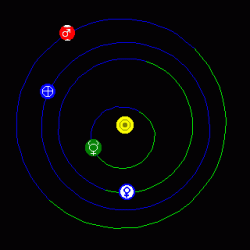If you have an open horizon to the east on Tuesday, February 26, you’ll have the opportunity to spot Mercury and Venus together. Both inner planets will team up in their closest approach and appear to be about a degree apart in the pre-dawn sky. For those with a telescope, this will be an excellent time to catch both planets in different phases at the same time in the eyepiece!
For many of us, the chances to spot the swift inner planet – Mercury – are few and far between. While Mercury traditionally gets about as bright as the stars in the Big Dipper, it’s proximity to the Sun makes it hard to see either right after sunset or just before the dawn. Low clouds on the horizon, sky light, obstructing trees or buildings… many things combine to make Mercury notoriously difficult to observe. However, when a bright star – or in this case, a planet – is nearby, the task becomes a whole lot easier!
 On the universal date of February 26, Mercury will appear low on the east/southeast horizon, precisely one hour before the Sun. Following it exactly two minutes later is brilliant Venus. Because of low position, chances are you’ll need binoculars to spot Mercury, but once your eyes have become accustomed, you may wish to try it unaided. The real treat will be to try and observe the pair telescopically. While it might seem dangerous since you’ll probably have to wait until the Sun is beginning to rise to catch them, don’t be afraid… It is perfectly safe to view them both during dawn.
On the universal date of February 26, Mercury will appear low on the east/southeast horizon, precisely one hour before the Sun. Following it exactly two minutes later is brilliant Venus. Because of low position, chances are you’ll need binoculars to spot Mercury, but once your eyes have become accustomed, you may wish to try it unaided. The real treat will be to try and observe the pair telescopically. While it might seem dangerous since you’ll probably have to wait until the Sun is beginning to rise to catch them, don’t be afraid… It is perfectly safe to view them both during dawn.
 Just like the phases of the Moon, both Mercury and Venus go through phases due to the relative position from which we view them. Take a look at the solar system as seen from above and you can easily understand why you see them as you do! Mercury will appear like the first quarter Moon, while Venus will be very gibbous. If you have filters, using them will help diminish the glare and make seeing the phases easier. If you do not. you can either wear a pair of sunglasses while at the eyepiece or wait until the skies begin to brighten. If the skies are cloudy, don’t worry. The pair will be visible for several mornings yet, but will begin to separate. Your observing job is to report which direction! Does Venus drop below Mercury or rise above?
Just like the phases of the Moon, both Mercury and Venus go through phases due to the relative position from which we view them. Take a look at the solar system as seen from above and you can easily understand why you see them as you do! Mercury will appear like the first quarter Moon, while Venus will be very gibbous. If you have filters, using them will help diminish the glare and make seeing the phases easier. If you do not. you can either wear a pair of sunglasses while at the eyepiece or wait until the skies begin to brighten. If the skies are cloudy, don’t worry. The pair will be visible for several mornings yet, but will begin to separate. Your observing job is to report which direction! Does Venus drop below Mercury or rise above?
Have fun!
Here are some fun facts about Mercury.

Hi today 26.02.08 I rose at 5.45 am and immediately I went to watch Venus and Mercury.There they were in the SE as seen in my country, Mauritius. Mercury was to the left of Venus, but dont remember above or below Venus. Well, of course I will continue to observe their direction. But one thing for sure is that Venus will drop down in the days and months to come. As for Mercury I think it will rise a bit above and then drop down.
Hey! That’s excellent!!!
I was hoping for a chance here, but we’re socked in with a winter storm. I very glad someone had the opportunity to observe them! Good job, Rikta!
i luv this good job tammy plotner KEEP IT UP!!!!!!!!!!!!!!!!!!!!!!!!!!!!!!!!!!!!!!!!!!!!